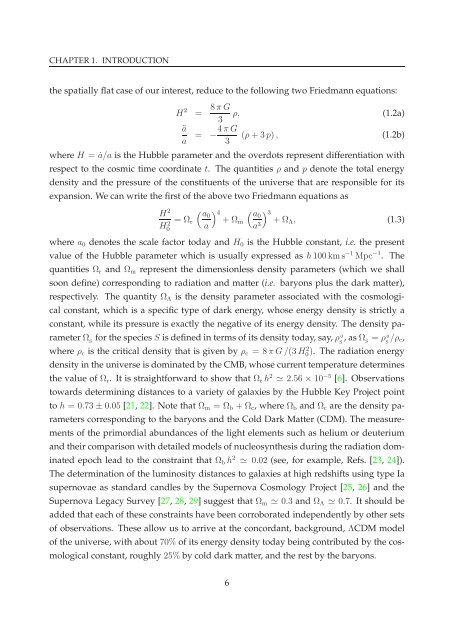PHYS08200605006 D.K. Hazra - Homi Bhabha National Institute
PHYS08200605006 D.K. Hazra - Homi Bhabha National Institute
PHYS08200605006 D.K. Hazra - Homi Bhabha National Institute
Create successful ePaper yourself
Turn your PDF publications into a flip-book with our unique Google optimized e-Paper software.
CHAPTER 1. INTRODUCTION<br />
the spatially flat case of our interest, reduce to the following two Friedmann equations:<br />
H 2 = 8πG ρ,<br />
3<br />
(1.2a)<br />
ä<br />
a = −4πG (ρ+3p),<br />
3<br />
(1.2b)<br />
where H = ȧ/a is the Hubble parameter and the overdots represent differentiation with<br />
respect to the cosmic time coordinate t. The quantities ρ and p denote the total energy<br />
density and the pressure of the constituents of the universe that are responsible for its<br />
expansion. We can write the first of the above two Friedmann equations as<br />
H 2<br />
H 2 0<br />
( a0<br />
) 4 ( a0<br />
) 3<br />
= Ω r +Ωm +ΩΛ , (1.3)<br />
a a 3<br />
where a 0 denotes the scale factor today and H 0 is the Hubble constant, i.e. the present<br />
value of the Hubble parameter which is usually expressed as h100kms −1 Mpc −1 . The<br />
quantities Ω r and Ω m represent the dimensionless density parameters (which we shall<br />
soon define) corresponding to radiation and matter (i.e. baryons plus the dark matter),<br />
respectively. The quantity Ω Λ is the density parameter associated with the cosmological<br />
constant, which is a specific type of dark energy, whose energy density is strictly a<br />
constant, while its pressure is exactly the negative of its energy density. The density parameterΩ<br />
S<br />
for the speciesS is defined in terms of its density today, say,ρ 0 S , asΩ S = ρ0 S /ρ c,<br />
where ρ c is the critical density that is given by ρ c = 8πG/(3H0 2 ). The radiation energy<br />
density in the universe is dominated by the CMB, whose current temperature determines<br />
the value of Ω r . It is straightforward to show that Ω r h 2 ≃ 2.56 × 10 −5 [6]. Observations<br />
towards determining distances to a variety of galaxies by the Hubble Key Project point<br />
to h = 0.73±0.05 [21, 22]. Note that Ω m = Ω b +Ω c , where Ω b and Ω c are the density parameters<br />
corresponding to the baryons and the Cold Dark Matter (CDM). The measurements<br />
of the primordial abundances of the light elements such as helium or deuterium<br />
and their comparison with detailed models of nucleosynthesis during the radiation dominated<br />
epoch lead to the constraint that Ω b h 2 ≃ 0.02 (see, for example, Refs. [23, 24]).<br />
The determination of the luminosity distances to galaxies at high redshifts using type Ia<br />
supernovae as standard candles by the Supernova Cosmology Project [25, 26] and the<br />
Supernova Legacy Survey [27, 28, 29] suggest that Ω m ≃ 0.3 and Ω Λ ≃ 0.7. It should be<br />
added that each of these constraints have been corroborated independently by other sets<br />
of observations. These allow us to arrive at the concordant, background, ΛCDM model<br />
of the universe, with about 70% of its energy density today being contributed by the cosmological<br />
constant, roughly 25% by cold dark matter, and the rest by the baryons.<br />
6
















